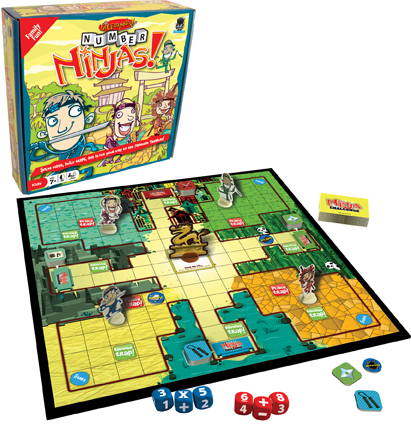While every kid is different and some little ones are whizzes when it comes to long division, math can be a tough subject at the grade school level. From addition and subtraction to telling time and multiplication, math can not only be difficult for kids to understand, but it can also be a pain in the tushie to get your kids to enjoy the concepts at hand.
While a board game isn’t going to single-handedly change the way your kids feel about math and schoolwork, Number Ninjas, from The Haywire Group, will absolutely get them to see that math can be fun—especially when there’s cool ninja weapons, exciting game play, and winning a golden dragon involved.
Designed for kids ages 7 and up, Number Ninjas features two levels of difficulty. Younger kids can use the Ninja Recruit dice, which only challenge them to add and subtract; while older kids can use the Ninja Master dice, which throw multiplication into the mix. This also means that older and younger kids can play together, which is great for families with siblings.
Players roll the three dice, perform the math equation, and move that many spaces. For example, if they roll “7 – 4” they get to move three spaces. Players must try to collect all four Ninja Quest tokens, which are placed on the four sides of the game board. In order to collect tokens, players must correctly answer Ninja Challenge questions. Here’s where the game gets challenging—especially for Ninja Masters.
Just like how there are two types of dice—easy and hard—there are two types of challenges. The Ninja Recruit questions feature basic math questions involving easy multiplication, addition and subtraction. The Ninja Master questions are more difficult and feature multi-step problems that often involve division. The game does not include pencil and paper—but you will absolutely need them. The questions are manageable for kids, but they are not problems they can perform in their heads.
The cards also show just how much math is needed in daily life. The Ninja Challenge cards all feature math problems based on real-world situations, such as “Nakashima babysat her little brother for 6 months and earned $132.00. How much money did she earn every month? If she babysat for 11 months, how much would she have made?” Questions like these show kids how practical math is, while also challenging them to figure out which operation they need to use—much more effective than simply placing “15 x 5 – 10” in front of them.
Once kids collect all four Ninja Quest tokens, they move their way to the center of the board to claim the Golden Dragon. This game is easily one of the most exciting, easy-to-learn, and seamless math learning games I have ever come across. While I wish parents luck in remembering exactly how to carry the 1 and use 0 as a place holder, this will be key in reinforcing what kids are learning in school and helping make these initially difficult concepts approachable and fun.

